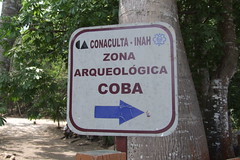
- our guide handed out water, took people to pay camcorder tax (blah blah blah), warned us that the walk was very long (4km to the main pyramid) and that in the jungle we were to make sure we touched *nothing*
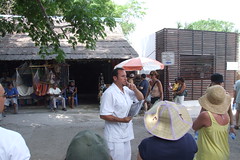
- showing us a wound on his hand where he touched a tree by accident, it had been two weeks now, and the bleeding still hadn't stopped (ulp!) -

- and then in through the "entrance"...trees proving rather difficult to avoid, being pretty much everywhere, on the other sites we would (by this stage) have been walking on well bordered paths, not so at Coba, the archaeology is still going on -

- believe it or not, this pile of rubble is actually what a lot of Chichen Itza looked like when the archaeologists first arrived, seeing the ruins in this untouched condition the plant-life they have removed and the jigsaw puzzles they have then solved are all the more impressive, the reason why this site is so overgrown and in comparatively poor condition is that it was only *really* examined in any detail by archaeologists in 1926, and serious work on the site only started in the 1970s (so you can really get a feeling for what it would have been like, spotting the mysterious piles of stone for the first time off in the jungle as an early adventurer - pretty exciting!) -
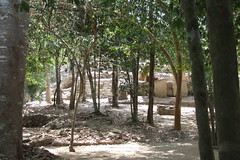
- anyway, we picked our way carefully through the brush, stopping briefly for our guide to draw a map of the site in the sand and tell us the built up area here is the largest in Yucatan at around 80(!) square kilometres (about the size of Plymouth), it sprang up here because of the proximity of two huge fresh water lagoons (and three smaller ones), the lands all around the city were an agricultural centre...estimates for the number of city dwelling inhabitants seem to put the elite at around 55,000 strong, with an unknown (but probably significantly greater) number of agricultural workers working the lands around...first stop proper was the Coba Group complex, starting with the main pyramid -
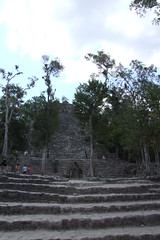
- the revelation here being that the archaeologists did a bit of digging (as this site was a bit of a state anyway) and discovered what was underneath the pyramid, the answer? Another pyramid -
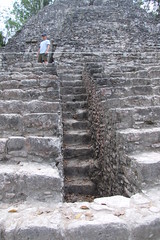
- it was explained that the Mayan's used their amazing powers of mathematics to work out (and I think it was on a 22 year cycle, but I could be corrected on that number) when it was time to add another layer onto the pyramid, so not just one pyramid but many, many pyramids, each more impressive than the one before (in order to appease the Gods)...another amazing feature of *this* pyramid are the grooves cut in this one side -

- the guide explained that when the (annual) great storms threatened as the winds start to pick up so these channels in the side set up a resonant hum, warning the residents in good time (in and no uncertain terms) that now would be a good moment to tie everything down...they had also uncovered a few tunnels -

- eating into the base of the pyramid, but there wasn't a lot to see down there (a few very dark, tiny, empty rooms)...from here we made our way to one of the two ball courts (the best preserved one) -
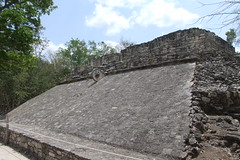
- where our guide showed us a very interesting carving (you will want to zoom right in, which may mean logging into Flickr/Yahoo!) -

- here he showed us (and it's very clear) the elongated head - the physical sign of the ruling elite (and here the rep reached out and turned a little girl's head away and then covered her ears, whispering to the adults), in his hands a blade, between his legs his erect penis, and he has used his knife to cause a river of blood to pour from his member to fertilize the land. The thought being, two teams of elite played this game (*not* sitting on high watching - actually playing) fighting for the honour (by thrusting the ball with their hips, aiming to get it through the circular opening) of being the one who has earned the right to give the divine blood from his penis to guarantee the rains and harvest...puts rather a different perspective on it, doesn't it...? Being a farmer looks a bit more attractive now... ;)
The last thing we were shown here, before starting the trek proper through the dense jungle were the skull carvings -
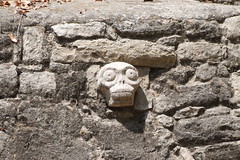
- not with hollow eyes, but staring - a sign, he said, that these people found no fear in death as they believed in life after...
All incredibly interesting, but there was much, *much* more to come...

No comments:
Post a Comment